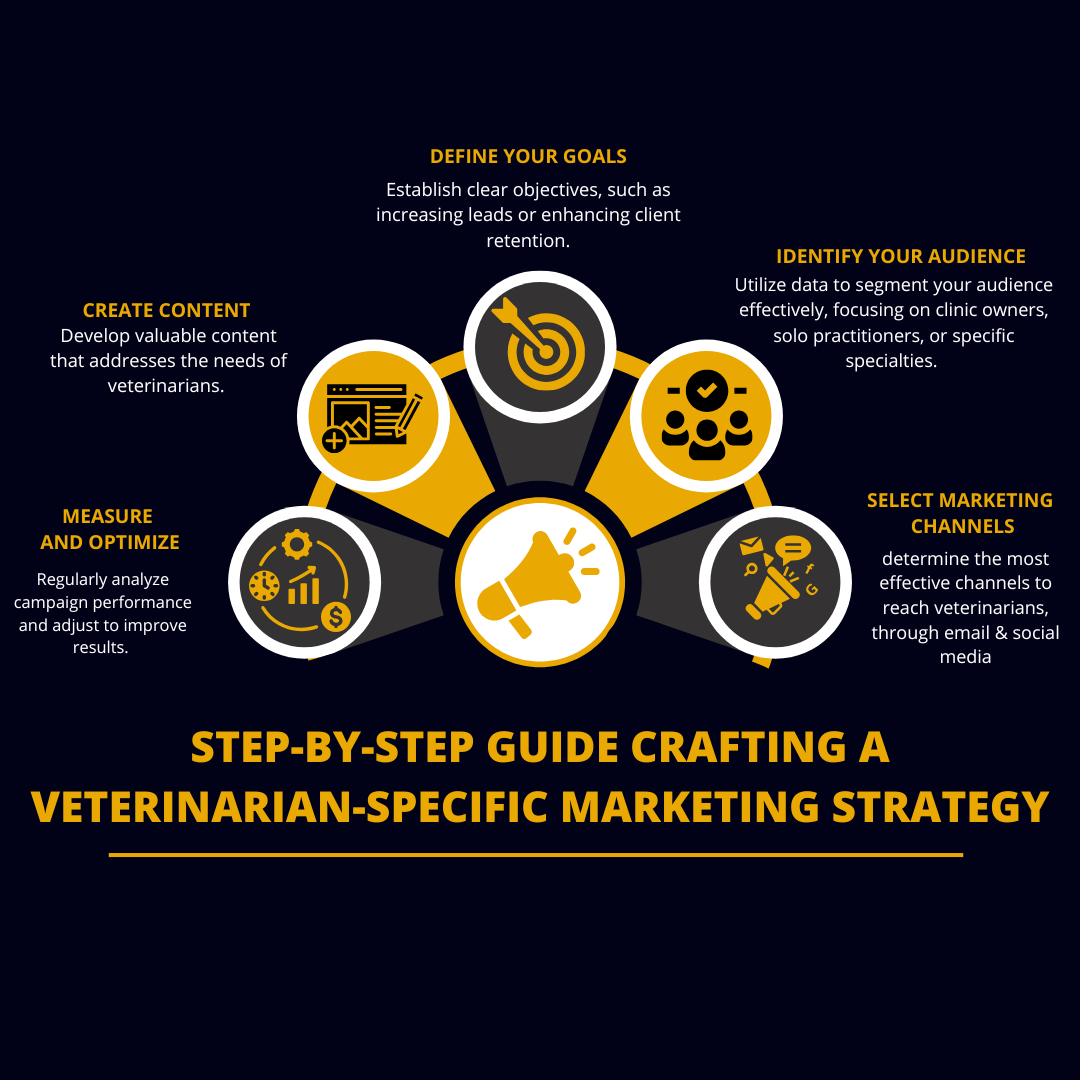
Marketing to veterinarians presents unique challenges that require a specialized approach.
The veterinary sector is rapidly evolving, with practices seeking innovative ways to joining with potential clients. With the rise of digital platforms, pet owners are searching for veterinary services more than ever. For B2B marketing, comprehending these dynamics is critical to effectively promoting their offerings.
Data-driven marketing provides the insights necessary to navigate these challenges and build brand awareness among veterinarians. This blog will explore proven and efficient strategies for connecting with veterinarians, enhancing your marketing strategy, and ultimately improving your outreach.
Understanding the Veterinarian Market
To effectively connect with veterinarians, it’s crucial to understand the unique dynamics and needs of the veterinary market
Market Segmentation: Solo Practitioners vs. Veterinary Clinics
When marketing to veterinarians, it’s essential to recognize the differences between various practices. Solo practitioners often operate independently, Emphasizing individualized care and fostering strong connections with pet owners.
In contrast, larger veterinary clinics may have multiple veterinarians and staff, allowing them to serve a broader client base but also necessitating more structured marketing efforts.
Key Demographic and Behavioral Trends in the Veterinary Field
Understanding veterinarian demographics and behaviors can significantly enhance your data driven marketing strategies. For example, many veterinarians in the United States are increasingly tech-savvy and receptive to online marketing tactics. Meanwhile, clinics in the UK may prioritize community engagement through local events and partnerships.
As a marketer, identifying these trends can help you tailor your campaigns to address veterinarians’ specific needs and preferences in different countries, such as the USA, UK, Canada, Australia, and Germany.
Insights into Veterinarians Purchasing Behaviors and Preferences
Veterinarians often make purchasing decisions based on various factors, including quality, price, and the reputation of the suppliers. Understanding these purchasing behavior criteria is essential for developing effective veterinary marketing strategies.
For example, many veterinarians value transparency and clear communication about products, making blog posts and informational content critical for building trust.
Why Data-Driven Marketing Works for Veterinarians
Data-driven marketing offers veterinarians a powerful way to reach their target audience with precision and maximising engagement.
Explanation of Data-Driven Marketing Principles
Data-driven marketing refers to leveraging data analytics to inform marketing strategies and decisions. This approach lets businesses gain insights into customer preferences, behavior, and demographics.
Marketers can craft tailored messages that resonate with veterinarians by utilizing data, increasing engagement, and driving conversions.
How Data Enhances Targeting, Personalization, and Campaign Effectiveness
Data plays a crucial role in enhancing targeting and personalization in marketing to veterinarians.
For example, businesses can use data analytics to personalize their audience based on specific criteria, such as clinic size or geographic location. This segmentation allows for more tailored marketing efforts that directly address the unique requirements of each group.
Case Study: Real-World Example of a Successful Data-Driven Campaign for Veterinarians
Overview
In an increasingly competitive veterinary supply industry, a leading veterinary supply company sought to enhance its engagement rates with customers and prospects. By employing data-driven insights and advanced analytics, the company successfully achieved a remarkable 40% increase in engagement rates over six months. This case study outlines the strategies implemented, challenges faced, and the resulting impact on engagement metrics.
Background
- Industry: Healthcare (Veterinary Supplies)
- Location: United States
- Objective: To increase customer engagement and improve overall marketing effectiveness.
Building a Veterinarian Marketing Plan
Creating a successful marketing plan for veterinarians involves understanding your audience, setting clear goals, and leveraging the right tools to drive engagement and growth.
Step-by-Step Guide to Developing a Marketing Strategy Tailored to Veterinarians

- Define Your Goals: Establish clear objectives, such as increasing leads or enhancing client retention.
- Identify Your Audience: Utilize data to segment your audience effectively, focusing on clinic owners, solo practitioners, or specific specialties.
- Select Marketing Channels: Based on your audience analysis, determine the most effective channels to reach veterinarians, whether through email, social media, or paid advertising.
- Create Content: Develop valuable content that addresses the needs of veterinarians, such as informative blog posts or engaging social media posts.
- Measure and Optimize: Regularly analyze campaign performance and adjust to improve results.
Defining Goals: From Lead Generation to Client Retention
A successful healthcare marketing strategy for veterinarians should encompass lead generation and client retention.
For instance, attracting new clients can be achieved through targeted social media marketing campaigns that highlight your services. Simultaneously, retaining existing clients might involve sending regular newsletters with tips and resources tailored to their needs.
Using Data to Identify the Right Marketing Channels
Different marketing channels yield varying results depending on the audience. Veterinary marketing can benefit significantly from email campaigns, as veterinarians often rely on email for professional communications.
Online Social networking sites like Facebook, Twitter, and LinkedIn can help enhance brand awareness and connect with veterinarians more personally.
Top Data-Driven Marketing Strategies for Veterinarians
Search Engine Optimization (SEO)
Optimizing your website and content for veterinary-specific searches is crucial. Use relevant keywords, such as “veterinary clinic” and “veterinary practices,” throughout your website to improve visibility on search engines. Consider creating informative content that addresses common questions pet owners search for, thereby driving traffic to your website.
Email Marketing
Building a veterinarian email list for targeted outreach is essential to veterinary marketing. Utilize MedicoLeads B2B healthcare database provider, to build verified veterinarian Email list and segment your list based on various criteria. This allows for more personalized communication and increases the chances of engagement.
Social Media Marketing
Social media marketing offers an outstanding opportunity to connect with veterinarians. To increase brand visibility, regularly post engaging content on platforms like Facebook and LinkedIn. Sharing informative articles, case studies, or even success stories can help capture your audience’s attention.
Paid Advertising
Utilizing paid advertising through platforms like Google Ads and social media can effectively target veterinarians. Craft ads that highlight the unique benefits of your products or services, ensuring they resonate with your audience. A/B testing different ad creatives can also provide insights into what works and what doesn’t.
Maximizing Data Insights: Tools and Tactics
To unlock the full potential of your marketing efforts, maximizing data insights through the right tools and tactics is essential for driving informed decisions and measurable results
Recommended Analytics Tools for Tracking Veterinary Marketing Performance
To enhance the effectiveness of your veterinary marketing efforts, utilize analytics tools like Google Analytics, HubSpot, or SEMrush. These platforms helps you to track key performance metrics, spot trends, and evaluate the success of different campaigns.
How to Use CRM and Email Automation to Nurture Leads
Implementing a Customer Relationship Management system helps you to manage and analyze customer interactions effectively. Coupled with email automation tools, you can foster leads by sending precise content based on their behavior and preferences.
Measuring Key Performance Indicators (KPIs) in Veterinary Marketing
Regularly measuring KPIs is vital for understanding the effectiveness of your marketing efforts. Focus on metrics such as email campaign open rates, social media post engagement rates, and paid advertising conversion rates. This data-driven approach will allow you to refine your strategies continually.
Overcoming Challenges in Market to Veterinarians
Marketing to veterinarians comes with unique challenges, but understanding these obstacles and implementing strategic solutions can turn them into opportunities for growth and stronger connections.
Common Obstacles: Long Decision Cycles, Niche Targeting, and Competitive Markets
Marketing to veterinarians can be challenging due to long decision cycles and the niche nature of the market. Many veterinarians may take time to evaluate new products or services before deciding. Additionally, competition within the veterinary sector can be fierce, making it crucial to stand out.
Solutions: Tailoring Offers, Personalization, and Building Trust with Veterinarians
To overcome these challenges, tailor your offers to meet the specific needs of veterinarians. Personalization can enhance engagement, while transparent communication fosters trust. Building solid relationships through informative content and dedicated support can improve your marketing outcomes.
Legal and Ethical Considerations When Marketing to Healthcare Professionals
Adhere to legal and ethical standards when marketing to veterinarians. Ensure compliance with B2B data regulations like GDPR and CAN-SPAM regarding advertising to healthcare professionals and prioritize transparency in your messaging.
Using Veterinarian Data for Targeted Outreach
Leveraging veterinarian data for targeted outreach allows you to tailor your marketing efforts, ensuring you connect with the right audience at the right time for maximum impact.
Methods to Gather and Verify Veterinarian Data
Accurate veterinarian data is crucial for successful outreach. Use reputable B2B healthcare database providers to obtain verified contact information. Additionally, consider conducting surveys or leveraging social media platforms to engage with your audience and gather insights.
How to Segment Your Audience for Targeted Campaigns
Audience segmentation helps you to customize your campaigns for better results.
For example, segmenting your audience into clinic owners versus individual practitioners can help you create more relevant messaging that resonates with each group.
Example: Crafting Personalized Messaging for Different Segments of the Veterinary Audience
When crafting your messaging, consider each segment’s specific pain points and needs. Clinic owners may be interested in efficiency tools, while individual practitioners might seek advice on client engagement strategies. Addressing these nuances can enhance your marketing efforts.
Trends to Market to veterinarians in 2024 and beyond
Veterinary marketing is evolving rapidly, and staying ahead of the latest trends in 2024 will help practices engage with clients more effectively and drive long-term success.
Emerging Trends in Veterinary Marketing
As we look toward the future, several trends are emerging in veterinary marketing. Telemedicine is gaining traction, allowing veterinarians to consult with pet owners remotely. Additionally, AI-driven insights are becoming invaluable for optimizing marketing strategies.
Predictions on the Future of Digital Marketing in Veterinary Medicine
The future of digital marketing in veterinary medicine will likely see increased reliance on data-driven approaches, personalized messaging, and a focus on building solid relationships with clients. Marketers who can adjust to these changes will thrive in the evolving landscape.
Conclusion
In summary, marketing to veterinarians requires a comprehensive understanding of the unique dynamics within the veterinary sector. Businesses can effectively engage with veterinarians, build brand awareness, and drive conversions by employing data-driven strategies. From leveraging analytics tools to crafting personalized messaging, the insights from data are invaluable in achieving marketing success.
Consider utilizing targeted veterinary data solutions to enhance your marketing efforts in the veterinary space. By harnessing the power of data, you can supercharge your outreach and create meaningful connections with veterinarians. Embrace the future of marketing, and let data guide your strategies to success.

